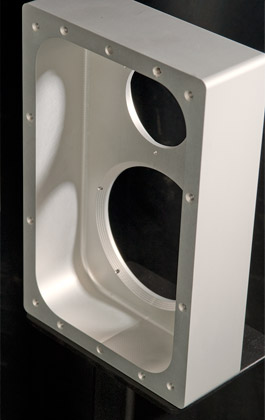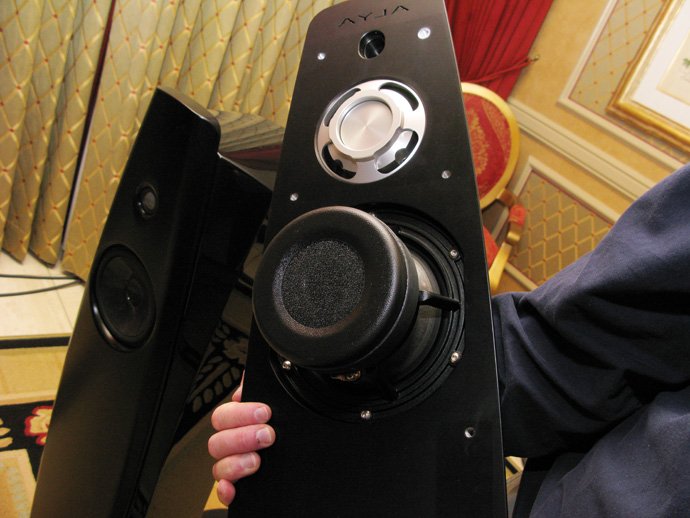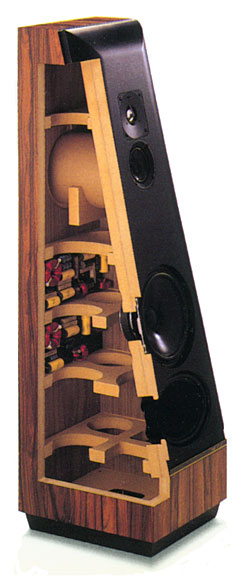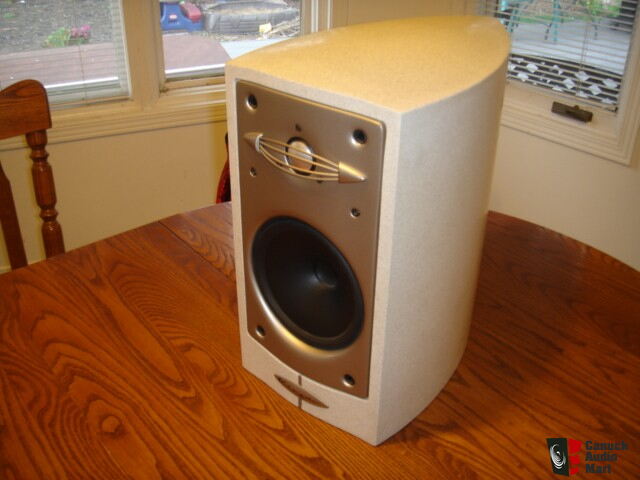andy19191 said:What is the physical explanation for a single travelling wave in a panel substantially changing the amount of sound radiated to the far field above and below the coincidence frequency?
I think i see your point. I am not visualizing the "coincidence effect" as known from architectural acoustics textbooks. I am just "plain" talking about coincidence frequency.
The (half ...?) bending wavelength should tell us something like the average "dipole pathlength" between two zones of a panel vibrating in antiphase. If that dipole pathlength is too small compared to wavelength in air (aka "surrounding medium"), then radiation is inefficient.
That is also the case in modal vibration. Of course modal shape plays a role, whether that mode is a "good radiating one" or not.
But sheer distances between antiphase zones are very critical for efficient radiation.
(edit: and of course - especially in the classical "coincidence effect" from architectural acoustics - superposition plays a role. But that is also the case in a modally radiating panel e.g.)
Last edited:
An accelerometer measures the vibration at a point on the panel. This point might be sitting on a node and not vibrating (e.g. aligned with one of the B&W internal matrix stiffening panels) or sitting on an anti-node and vibrating a lot (e.g. between the internal stiffening panels). Where did Stereophile place their accelerometer for the first few mode shapes?
Hi i read right in the center of the panel where bending should be maximum
Close to the corners the bending is reduced of course
I guess that even a simple stiffener combined with some kind of dampener placed right in the middle of the panels should have a beneficial effect.
If one wishes to investigate sound from a vibrating cabinet one needs to measure at a lot of points over the whole enclosure. You need not only the magnitude but the phase as well in order to know which parts of the panel are going in and which are going out with respect to each other. The spacing between the points needs to be close enough to resolve the mode shapes of the highest frequency of interest
You mean that even the corners could emit sounds maybe at higher frequencies ? It could be and also rounding the edges of the cabinet could be beneficial in this regards ?
It is an issue extremely complex and also intriguing because IMHE i got evidence that the cabinet can influence a lot the overall performance of a speaker, especially of course in a full range speaker.
For instance speaking of cheap commercial speakers usually a 2 ways bookshelf gives a much better soundstage rendition than a 2 ways tower because the tower has more extended panels that can vibrate more.
Unless the tower is something like this ... this does not vibrate even when a bomb explodes inside 😱

when speakers this big disappear sonically that is the magic for me
With the sound is completely outside the cabinets and the speakers seem even disconnected from the playback system.
Just wonderful.
Regards, gino
"An accelerometer measures the vibration at a point on the panel. This point might be sitting on a node and not vibrating (e.g. aligned with one of the B&W internal matrix stiffening panels) or sitting on an anti-node and vibrating a lot (e.g. between the internal stiffening panels). Where did Stereophile place their accelerometer for the first few mode shapes?"
Measuring Loudspeakers, Part Two Page 6 | Stereophile.com
The second paragraph under "Panel Vibration Behavior" mentions that the accelerometer is placed in several locations.
Is this accelerometer more of strain gage, and therefore measuring vibration by panel flexing, than actual acceleration?
Measuring Loudspeakers, Part Two Page 6 | Stereophile.com
The second paragraph under "Panel Vibration Behavior" mentions that the accelerometer is placed in several locations.
Is this accelerometer more of strain gage, and therefore measuring vibration by panel flexing, than actual acceleration?
Last edited:
.
Unless the tower is something like this ... this does not vibrate even when a bomb explodes inside 😱
An externally hosted image should be here but it was not working when we last tested it.
when speakers this big disappear sonically that is the magic for me
With the sound is completely outside the cabinets and the speakers seem even disconnected from the playback system.
Just wonderful.
Regards, gino
A link to Stereophile panel test, for what its worth.
Rockport Technologies Antares loudspeaker Measurements | Stereophile.com
Hi and yes that is the speaker.
I have a further question maybe it is a silly one. 😱
I read that if the speaker is not stiff it tends to dissipate woofer 's energy that is bad because this energy should go to the listening room in form of sound pressure.
In the same way decoupling mechanically the woofer frame from the speaker cabinet for example with a rubber ring is a bad solution because also here part of the woofer energy is dissipated and not emitted (sorry for both the poor english and poor use of the terms).
Instead the woofer frame must be very rigidly mechanically coupled to the front baffle and consequently to the whole cabinet.
In this way most of the woofer energy will be transformed in sound pressure.
This i think would be very evident if we mount woofer on springs ... the woofer emission would be extremely reduced.
The more the frame will stay still the more the power in the sound emission.
This will give a stronger dynamic to the speaker of course.
In general it is good that all the energy is transformed in sound i think.
Is it correct ?
Thanks, gino
I have a further question maybe it is a silly one. 😱
I read that if the speaker is not stiff it tends to dissipate woofer 's energy that is bad because this energy should go to the listening room in form of sound pressure.
In the same way decoupling mechanically the woofer frame from the speaker cabinet for example with a rubber ring is a bad solution because also here part of the woofer energy is dissipated and not emitted (sorry for both the poor english and poor use of the terms).
Instead the woofer frame must be very rigidly mechanically coupled to the front baffle and consequently to the whole cabinet.
In this way most of the woofer energy will be transformed in sound pressure.
This i think would be very evident if we mount woofer on springs ... the woofer emission would be extremely reduced.
The more the frame will stay still the more the power in the sound emission.
This will give a stronger dynamic to the speaker of course.
In general it is good that all the energy is transformed in sound i think.
Is it correct ?
Thanks, gino
Last edited:
Hi and yes that is the speaker.
I have a further question maybe it is a silly one. 😱
I read that if the speaker is not stiff it tends to dissipate woofer 's energy that is bad because this energy should go to the listening room in form of sound pressure.
In the same way decoupling mechanically the woofer frame from the speaker cabinet for example with a rubber ring is a bad solution because also here part of the woofer energy is dissipated and not emitted (sorry for both the poor english and poor use of the terms).
Instead the woofer frame must be very rigidly mechanically coupled to the front baffle and consequently to the whole cabinet.
In this way most of the woofer energy will be transformed in sound pressure.
This i think would be very evident if we mount woofer on springs ... the woofer emission would be extremely reduced.
The more the frame will stay still the more the power in the sound emission.
This will give a stronger dynamic to the speaker of course.
In general it is good that all the energy is transformed in sound i think.
Is it correct ?
Thanks, gino
It would be reduced according to Newtons 2 law.
That means that the weight of the chassis vs the mms would determine how much. With a "normal" speaker it results to something like 0.1-0.2db reduction of the output, but a large reduction in transmission of unwanted mechanical energy exciting the cabinet.
http://www.google.no/url?sa=t&rct=j&q=&esrc=s&source=web&cd=5&ved=0CEEQFjAE&url=http%3A%2F%2Fwww.linkwitzlab.com%2FDriver%2520Decoupling.doc&ei=I1mxVJyVLsfvUKSCg_gL&usg=AFQjCNGkQTTYGDOWJM0C3HrMXBTd114gGA&bvm=bv.83339334,d.d24
It would be reduced according to Newtons 2 law.
That means that the weight of the chassis vs the mms would determine how much.
With a "normal" speaker it results to something like 0.1-0.2db reduction of the output, but a large reduction in transmission of unwanted mechanical energy exciting the cabinet....
Hi and thanks a lot for the very valuable explanation.
So nothing to be worried of. Good ! another issue solved.
I have still the feeling that the vibrations of other panels than the front baffle should not be that impacting in the soundstage performance of the speaker.
They are extremely lower compared to the front emission.
Instead i think the "main suspect" is the front baffle.
A thick baffle (or maybe stiffened ?) could be a good point to start.
I am still confused because i see front panel only stiff and not that heavy.
Let's say that i see front baffle realized in very different way.
Some examples here under taken from good commercial speakers.
Thanks again, gino



ginetto61 said:I am still confused because i see front panel only stiff and not that heavy.
Let's say that i see front baffle realized in very different way.
Some examples here under taken from good commercial speakers.
It's not just you being confused, but a an indicator that many designers even in the "commercial sector" are confused too ...
Many speaker's cabinets try to fight with physics in a ridicoulus way instead of making use of it.
In a wideband cabinet (not just a subwoofer) dominating mass and damping is needed.
Decoupling the driver - by mounting it via a damped kind of spring to the cabinet - may reduce excitation of the cabinet from e.g. 6dB/octave to even 12db/octave.
Decoupling is equivalent to inserting a higher order lowpass filter mechanically between the exiter (driver's basket) an the cabinet (=structure able to vibrate and radiate unwanted sound).
Thus decoupling in a wideband used enclosure (e.g. a 2-way) is an economic solution to reduce unwanted sound radiation especially in the midrange. See attached example below.
In a subwoofer decoupling is both impractical and unecessary, given the cabinet is designed for dominating stiffness.
If one wants to make a
- stiffness dominated cabinet as a subwoofer ("push eigenmodes out of used band")
and
- a mass & damping dominated cabinet ("keep eigenmodes low in frequency for less audibility, rely on mass hampering and damping in upper bass and midrange")
in the very same construction, what you get is a cabinet suffering from schizophrenia.
Schizophrenia in design comes with 3 main symptoms
- construction overly large and heavy
- bill of materials excessively expensive
- missing the design goals
It is very simple indeed:
The "stiffness dominated subwoofer approach" has to be released from the cabinet transmitting the band above the lowest and mid bass. Alternatively both structures have to be decpouled "as if they were separated".
The later approach is not wise IMO, because the best position in the room for a subwoofer is never identical whith the best position for the satellites anyways ...
Thus splitting the band into a subwoofer and separated satellites is always of advantage for different reasons:
Ability to meet different requirements in cabinet design is just one advantage in subwoofers among others, like ability to excite the room below Schroeder Frequency in a more balanced manner using separated subwoofers at well chosen positions in the listening room.
"Good sound" is always trading and meeting different goals at the same time. All who are engaged with those matters over a longer period of time know that ...
Especially when using "conventional boxes" there is no "HiFi" without subwoofers IMO.
(Sorry for "buzzkilling")
Kind Regards
Last edited:
Remark:
Just an example for "decoupling" strategy:
http://www.eclipse-td.com/uk/products/td-m1/images/tdm1-06.jpg
Just an example for "decoupling" strategy:
http://www.eclipse-td.com/uk/products/td-m1/images/tdm1-06.jpg
LineArray said:Especially when using "conventional boxes" there is no "HiFi" without subwoofers IMO.
At least this holds IMO for the usually smaller "european living room" in a house built from stone, where room modes place a serious problem.
Domiciles made from wood, also having larger living rooms, may not suffer from room modes in the bass to the same extent, as there is a lower Schroeder Frequency to be expected and more absorption due to non rigid walls.
Kind Regards
Remark:
Just an example for "decoupling" strategy:
http://www.eclipse-td.com/uk/products/td-m1/images/tdm1-06.jpg
Hi and thanks again and very interesting speaker indeed !
i heard of that speaker and that it sounds quite remarkable within its physical limits of course.
But when a concept is "sound" i think it could be upscaled quite easily.
I like this concept a lot.
I wonder how could it sound a nice let's say Tannoy coaxial with an arrangement like the one in the picture ... very very intersting. 🙄
Thanks again, gino 🙂
It would be reduced according to Newtons 2 law.
That means that the weight of the chassis vs the mms would determine how much. With a "normal" speaker it results to something like 0.1-0.2db reduction of the output, but a large reduction in transmission of unwanted mechanical energy exciting the cabinet...
Hi i promise the last question.
Could you please confirm me that the reduction in level between a very rigid cabinet and a damped but not rigid one is only 0.2dB ? 😕
this low ? can we be sure about this ?
It seems next to nothing to me . Cannot be that low.
I am reading a lot about cabinets these days. The designers made big efforts to get very stiff cabinets also in the past, like the B&W Matrix concept or the Celestion SL600, SL700 and Kingston.

Please do not worry ... i am stopping this now.
But it is just a so intriguing topic. The possibility to keep the benefit of a box without having to live with its drawbacks ... exciting ! 😱
Thanks for the patience. Have a nice day 😀
gino
Last edited:
Hi i promise the last question.
Could you please confirm me that the reduction in level between a very rigid cabinet and a damped but not rigid one is only 0.2dB ? 😕
this low ? can we be sure about this ?
It seems next to nothing to me . Cannot be that low.
That is not what my paper says!
it seems that many people refer to this paper, but often misunderstand it Oliver excepted 🙂 )
The quoted reduction in output is that of cone acceleration between a driver being freely suspended or connected to a cabinet.
As Oliver says, for a subwoofer, use a cabinet where the first modal frequency of the cabinet is well above the crossover frequency. It will then never be excited.
In a full range speaker system, separate the driver/cabinet behavior into frequency ranges: Woofer operates into a cabinet where the modal behavior is above the crossover frequency, midwoofer operates into an appropriately braced and DAMPED enclosure, midrange is decoupled from the enclosure.
Andrew
Hi i promise the last question.
Could you please confirm me that the reduction in level between a very rigid cabinet and a damped but not rigid one is only 0.2dB ? 😕
this low ? can we be sure about this ?
It seems next to nothing to me . Cannot be that low.
I am reading a lot about cabinets these days. The designers made big efforts to get very stiff cabinets also in the past, like the B&W Matrix concept or the Celestion SL600, SL700 and Kingston.

Please do not worry ... i am stopping this now.
But it is just a so intriguing topic. The possibility to keep the benefit of a box without having to live with its drawbacks ... exciting ! 😱
Thanks for the patience. Have a nice day 😀
gino
Hmm, I might have been unclear. But as Andrew I was talking about reduction of the cone acceleration. If the cone acceleration hardly changes, the SPL produced by the cone will hardly change aswell. Pressure = Force pr area. Force = M*A.
You mentioned B&W matrix. Have you read their tech page?
Bowers & Wilkins - Decoupling
Bowers & Wilkins - Matrix
That is not what my paper says!
it seems that many people refer to this paper, but often misunderstand it Oliver excepted 🙂 )
Hi and thanks for the kind reply
i knew i was wrong 😱
The quoted reduction in output is that of cone acceleration between a driver being freely suspended or connected to a cabinet.
As Oliver says, for a subwoofer, use a cabinet where the first modal frequency of the cabinet is well above the crossover frequency. It will then never be excited.
In a full range speaker system, separate the driver/cabinet behavior into frequency ranges: Woofer operates into a cabinet where the modal behavior is above the crossover frequency, midwoofer operates into an appropriately braced and DAMPED enclosure, midrange is decoupled from the enclosure.
Andrew
I see. Just to to end this issue ... what do you think of the Celestion approach in the SL600/700 ?
I suppose they were wrong to go for a very stiff cabinet because they actually abandoned this design and never went back.
So what is needed is damping and not stiffening of the cabinet.
Thanks a lot. Kind regards, gino
Hmm, I might have been unclear.
But as Andrew I was talking about reduction of the cone acceleration. If the cone acceleration hardly changes, the SPL produced by the cone will hardly change aswell. Pressure = Force pr area. Force = M*A.
Hi and thanks for the valuable reply
Reduction of cone acceleration sounds very very bad to me
I like cones that react fast to signal.
and that stop also fast when signal stops.
You mentioned B&W matrix. Have you read their tech page?
Bowers & Wilkins - Decoupling
Bowers & Wilkins - Matrix
No and thanks for the links !
i have huge respect for B&W brand.
I think that they are underrated in some way. They have designed and built something of very innovative like the Nautilus series.
I will read those papers with the greatest interest.
Thanks again. Kind regards, gino
Hi and thanks for the valuable reply
Reduction of cone acceleration sounds very very bad to me
I like cones that react fast to signal.
and that stop also fast when signal stops.
No and thanks for the links !
i have huge respect for B&W brand.
I think that they are underrated in some way. They have designed and built something of very innovative like the Nautilus series.
I will read those papers with the greatest interest.
Thanks again. Kind regards, gino
Okey, then I guess you will be dissapointed to see they decouple both the midrange and tweeter.
And the designers of the Nautilus that now designs Vivid audio, also do the same. They do it for the bass driver aswell actually.
SoundStage! Ultra | SoundStageUltra.com (UltraAudio.com) | Searching for the Extreme: Laurence Dickie of Vivid Audio -- Part Two
A difference so small that it is within the measurement error of hobbyist like us do not worry me at all.
Especially when you see how much better behaved both the chassis and panels are in Andrew's example. Like it was said, it's probably the most cost effective way to lower cabinet ressonance.
Interesting discussion. I'm not sure I follow all the technical aspects, but the recommendations seem helpful.
If one is attaching drivers to the front baffle in the traditional manner, what sorts of materials would make for a decent gasket between the driver and baffle?
If one is attaching drivers to the front baffle in the traditional manner, what sorts of materials would make for a decent gasket between the driver and baffle?
Okey, then I guess you will be dissapointed to see they decouple both the midrange and tweeter....
Thanks a lot for the extremely interesting link (i read great things of Vivid Audio) but this will take me all the weekend to read 😱
and i will read it carefully for sure
Just to end for now, the nice thing is that i read one thing from a designer and the exact opposite from another, and they are both extremely praised.
So it seems that both have got it right in the end following an opposite approach 😕
The opposite case being, if i get it right, Magico where the drivers are bolted to an extremely solid and unbelievably stiff structure, an internal frame.
The baffle is not holding the drivers and the panels just seal the cabinet like covers.
So maybe there is more than one truth 🙄
But i will read first ... i just need time
Thanks again, gino
Last edited:
I have to admit, as a bit of an outsider to the electronics/audio technical world, that's how things appear to me as well. In the end it seems the best thing to do is to try various approaches and see which one works best for you (at least that's my impression).Just to end for now, the nice thing is that i read one thing from a designer and the exact opposite from another, and they are both extremely praised.
So it seems that both have got it right in the end following an opposite approach 😕
The opposite case being, if i get it right, Magico where the drivers are bolted to an extremely solid and unbelievably stiff structure, an internal frame.
The baffle is not holding the drivers and the panels just seal the cabinet like covers.
So maybe there is more than one truth 🙄
But i will read first ... i just need time
Thanks again, gino
- Status
- Not open for further replies.
- Home
- Loudspeakers
- Multi-Way
- how to brace a speaker cabinet?